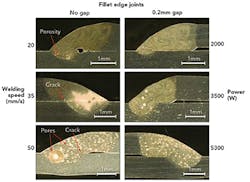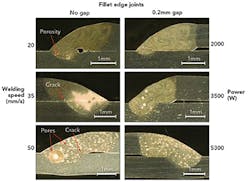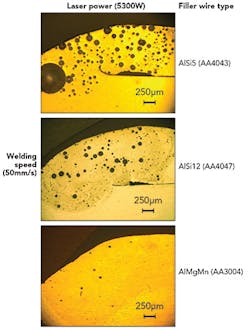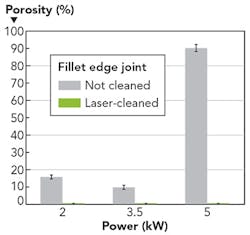Process reduces porosity formation in laser-welded aluminum alloys
LIN LI
Aluminum (Al) alloys are typically used in the automotive, aerospace/aeronautical, and sport industries due to their light weight, ease of forming/machining, and acceptable strength properties. Joining Al alloy panels and sheets is typically realized by mechanical riveting, arc welding, brazing, friction-stir welding, laser welding, and hybrid laser/arc welding. Laser welding can be very fast and generates low thermal distortions. However, laser welding of Al alloys often results in significant amount of porosity, thus very low joint strengths—typically 50–75% that of the parent material.
There are a number of reasons for porosity generation in laser welding of Al alloys:
1. Surface contamination, including hydrogen in the surface oxide layer. Hydrogen (H2) is typically trapped in the surface oxide layer on the Al alloys' surfaces. During laser welding, they can be released and dissolved in the melt pool. Hydrogen solubility in liquid Al is much higher than that in the solid. In liquid, the H2 solubility [1] is:
where S is the solubility of hydrogen (mL/100 g Al) at 273°K and 760 torr, T is the temperature (K), and P is the partial pressure of hydrogen (1 torr =0.133 mbar) [2].
From the above, it can be seen that the H2 solubility in Al liquid is about 20 times of that in solid. Thus, Al alloys can take in large amount of H2 in the molten pool and release them as porosity during solidification. Other surface organic contaminants such as oil and grease can also contribute to the hydrogen gas trapping in the weld zones. Porosities generated by hydrogen trapping are normally small (<0.5mm in diameter) and typically in a few 10s of micrometers. Porosity in the melt pool moves slowly. The porosity moving speed [2] can be found using:
where r is the radius of the pore; Δþ is the difference in density between the liquid and the gas inside the pore; g is gravitational acceleration; μ is the dynamic viscosity of the liquid; and þ is the liquid density. For a 50μm-diameter pore in the Al alloy, its moving speed is 4–6mm/s while the liquid solidification speed is normally 20–50mm/s, thus difficult to get out [3].
2. Keyhole porosity. This occurs typically in keyhole (deep-penetration) welding, where the laser power density is normally above 106W/cm2. For welding relatively thick (>3mm) Al alloys, keyhole welding is necessary to enable the deep penetration. Keyholes are formed as a result of high-pressure vapor/plasma generation during laser welding that result in a deep vapor hole due to the high recoil pressure as the vapor leaves the melt pool. Such a keyhole allows the laser beam to be absorbed in much deeper part of the material compared with that at lower-power-density, conduction-based laser welding. If the keyhole is not stable (when the material surface tension is greater than the vapor recoil pressure, keyhole collapse) or the material solidifies too quickly, vapor could be trapped in the fusion zone and forms large porosities (typically >0.5mm).
3. Vaporization of alloy elements. Material alloy elements such as magnesium (Mg), manganese (Mn), copper (Cu), and silicon (Si) can be vaporized and trapped in the fusion zone, forming porosity. These alloy elements can also play a role of modifying the material surface tension and viscosity.
There have been a number of methods that can be used to reduce porosity in laser welding of light alloys; for example, the use of controlled gas jet [3], the use of an oscillating beam [4], welding with twin beams [5], and surface cleaning [6]. Porosity is usually less for conduction-limited laser welding with low laser-power densities, but the process efficiency is usually lower.
In this article, a case study is reported on the use of a laser cleaning technique for the reduction of weld porosity in laser welding of automotive 6000 series alloy (AA6014) or commonly known as AC-170PX that has 0.5–0.7% Ai, 0.35 (max.) F, 0.2 (max.) Cu, and 0.05–0.2 Mn. During the Al alloy sheet forming process, the Al surfaces were coated with titanium and zirconium (4mg/m2) and a dry lubricant (AlO70 at 1.5g/m2) and left on the surface after their forming. The welding was carried out with a filler wire and a 5.3kW disk laser.
Effect of laser power, speed, and sheet gap on porosity
FIGURE 1 shows the effect of laser power (2–5.3kW), welding speed, and the gap between the sheets on weld porosity formation with a fillet edge welding configuration using a filler wire of AA4043 (5.3% Si) [7]. Under each welding condition, the line energy (energy per unit length) is similar, but at higher laser powers (and high speed), porosity is more. Leaving a gap between the sheets can significantly reduce the porosity, but still too high. These porosities are typically <200μm in diameter, as shown in FIGURE 2 [7].
Effect of filler wire on porosity
FIGURE 3 shows the effect of three different types of filler wires: AA4043 (5.2% Si), AA4047 (12% Si), and AA3004 (0.3% Si and 1–1.5% Mn. and 0.8–1.3% Mg) on porosity formation in laser welding of AA6014 alloy [8]. Higher content of Si and Mg/Mg seem to help reduce porosity formation. Si increases the material fluidity and decreases the liquid phase viscosity, thus reducing porosity. Mn/Mg, although it vaporizes more easily, can compensate for the loss of these elements in the Al alloy. Mn and Mg reduce the surface tension, thus reducing the keyhole collapsing opportunity.
Effect of laser cleaning on porosity
Laser cleaning was carried out using a nanosecond pulsed Nd:YAG laser (600W) with a raster scan (at 95 mm/s) to remove around 20μm thickness of surface layer. FIGURE 4 compares laser weld porosity formation with and without laser cleaning [9]. Clearly, with all three laser welding parameters, laser cleaning has significantly reduced porosity and achieved less than 1% porosity in all cases.
Industrial application
The described laser cleaning/welding technology has now been practically implemented for automotive production at Jaguar and Land Rover in the UK. The scientific findings provide increased confidence and understanding in introducing the laser welding technology for welding the Al alloy.
Conclusion
The research has clearly demonstrated the benefit in introducing laser cleaning in improving the quality (reducing porosity) in laser welding of Al alloys, and the technology is practically implemented in industry. It is worth noting that although laser cleaning has played a critical role in reducing welding porosity in welding thin Al alloys, it may not be so effective for welding thick-section Al alloys, as porosity may be dominated by the keyhole effect rather than surface oxide and contaminations.
ACKNOWLEDGEMENT
The work was carried out at The University of Manchester by PhD student Ahmad Alshaer, who was funded by the Syria government and collaborated with Jaguar and Land Rover. He was supervised by Professor Lin Li from The University of Manchester and Mr. Anil Mistry from Jaguar and Land Rover.
REFERENCES
1. C. E. Ransley and H. Neufeld, Metall. Trans. A, 20, 9, 1785–1791 (1989).
2. H. Zhao, D. R. White, and T. DebRoy, Int. Mat. Rev., 44, 6, 238–266 (1999).
3. J. Blackburn, C. Allen, P. Hilton, and L. Li, J. Laser Appl., 22, 2, 71–78 (2010).
4. E. Blackburn et al., Sci. Technol. Weld. Join., 15, 5, 433–439 (2010).
5. J. Blackburn, C. M. Allen, A. Khan, P. A. Hilton, and L. Li, Laser. Eng., 22, 5–6, 319–336 (2012).
6. M. W. Turner, P. L. Crouse and L. Li, Appl. Surf. Sci., 253, 19, 7992–7997 (2007).
7. A. W. Alshaer, L. Li, and A. Mistry, J. Manuf. Sci. Eng., 137, 021011-1 (2015).
8. A. W. Alshaer, L. Li, and A. Mistry, "The effect of filler wire types on porosity formation in laser welding of AC-170PX aluminum alloy for automotive component manufacture," Proc. IMechE, Part B, J. Eng. Manufacture, http://dx.doi.org/10.1177/0954405415578584 (Apr. 7, 2015).
9. A. W. Alshaer, L. Li, and A. Mistry, Opt. Laser Technol., 64, 162–171 (2014).
LIN LI([email protected]) is the director of Laser Processing Research Centre at the School of Mechanical, Aerospace and Civil Engineering at The University of Manchester, Manchester, England.






